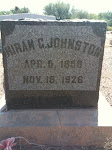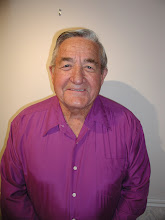January 27, 2018 Interview of Lavar Johnston
by Edres Barney for Eastern Arizona Museum & Historical Society of Graham County
Part 1:


January 27, 2018 Interview of Lavar Johnston
by Edres Barney for Eastern Arizona Museum & Historical Society of Graham County
Part 1:

After completing the summer session of 1949 at Arizona State College, I was ready to graduate. The graduation wouldn’t take place until the spring of 1950. At this time, I needed to find a permanent job. So I attempted to find work in the business field because my degree from college was in marketing and advertising. I tried several salesman type jobs locally, but none of them showed any real future. I finally went to work at the O.S. Stapley Hardware Store in Mesa, Arizona. My thinking was that this would have given me many opportunities to grow with the company and we were experiencing a population boom in the area. I worked as a warehouseman, a delivery man, stocker and an occasionally as a floor salesman. One of the greatest blessings in this job was that I worked closely with my uncle Bert Stapley, the husband of my father’s oldest sister Nina, whom I always loved very much. I also worked with Lester Carpenter, an old timer from the Eden area whom I respected very much. One of the assistant delivery men was an African-American by the name of Gene Johnson. Gene and I learned to get along fabulously. During the year of 1949, Gene helped me to become more aware of the plight of African-Americans. After working there for about a year, I realized the Stapley family had many young men my age who were planning to grow with the company.
My family and I purchased our first home at 252 W. 9th Pl. N. in Mesa, Arizona. It was a small 3 bedroom, 1 bath tract home which accommodated our young family comfortably. It was around this time that I went to work at Williams A.F.B. in warehouse number one as a warehouseman, the same job I had performed before I joined the U.S. Navy in 1944. I was working with an entirely different crew, however, at warehouse number one. After working there for one year, my family and I took a vacation and traveled to Salida, Colorado, where my wife Wanda was born and we visited her sister Velma and her family.
I had been very closely associated with my Bishop, Charlie Standage, who was a C.P.A. who worked at the County Assessors’ Office. He had called me to be an assistant Ward clerk in our Mormon Church, being in charge of finances. He was very pleased with my work, so when the Maricopa County Sheriff, Cal Boies asked him for assistance in finding a young man to work as a deputy sheriff in the Mesa area, Bishop Standage recommended me after asking if I would be interested. I was very excited about what experiences and opportunities this would offer.
Particularly meaningful to me was the fact my grandfather Ray Lamoreaux had been a Graham County Deputy at one time and my uncle, Dallas Johnston, had been a Mesa City Police Officer. But before I could become a deputy sheriff in the Mesa area, I had to travel to Phoenix for a few months to complete training before I could work alone as a deputy sheriff without a partner. Sheriff Boies swore me in as a deputy sheriff, issued me a badge, instructed me to purchase a gun, a cowboy hat, boots and then issued me uniform shirts.



Gene was 4 years behind me in school because the school cut off date used to be January first. Gene and cousin Normand Hancock had January birthdays. Gene went back up to Pima to play High School football and stay with Lawrence and Lelia Hancock his freshman year.

The Wheaties chose the Mesa team to make a documentary film to be used for the training of football officials. Years later as an Arizona football official I watched this film. Gene had broken a finger and played with his hand in a cast. In the film he was shown intercepting a pass with his casted hand and of course the other hand.
Gene played football at Mesa High his next 3 years. Wilford Whizzer White was a grade ahead of Gene and was Mesa's main ball carrier. I was there for every game of 1946, 1947, and 1948 to see Gene play tackle on the state champion football team. Gene played both offense and defense. He was a great blocker for "Whizzer" White. The Mesa High School still won state the year after "Whizzer" White graduated. A big full back Don McClintock was their main offensive weapon.
Wilford Whizzer Waite went to Arizona State College in my Junior year. An old friend and neighbor from Bryce, Roy Beach, had played two years at Gila College in Thatcher, Arizona had moved to mesa to attend

Arizona State College. I went out for football with Roy under a new coach, Ed Doughty. We both played guard. Some other Mesa guys tried out for them too. Doughty had been coaching at Boston College and he had bought a whole team with him from back east putting them on scholarships. Roy and I could out play the guards he had brought but guess who got to play in the games! We were both married and had a son so we decided against wasting our time so we quit.
My son Daniel L. Johnston was born December 6, 1947. He was a real joy, a real great child. We used to take him to a football games and he would pur on quite a show. We taught him to root for Whizzer White.
Our best frinds in Mesa were Bob and Betty Medril in our ward at First. Wilford White married Bob's sister Shirley Merril. Shirley and Wilford played cards with us at B0b and Betty's often and Danny would demonstrate his cheers for the "Whizzer". They named their first son, Danny.

White played for the Chicago Bears for the 1951 and '52 seasons but became injured ending his NFL career. Former Dallas Cowboy quarterback Danny White was the son of Wilford White. Danny lead the Cowboys to three consecutive NFC championship games (1980-1982)